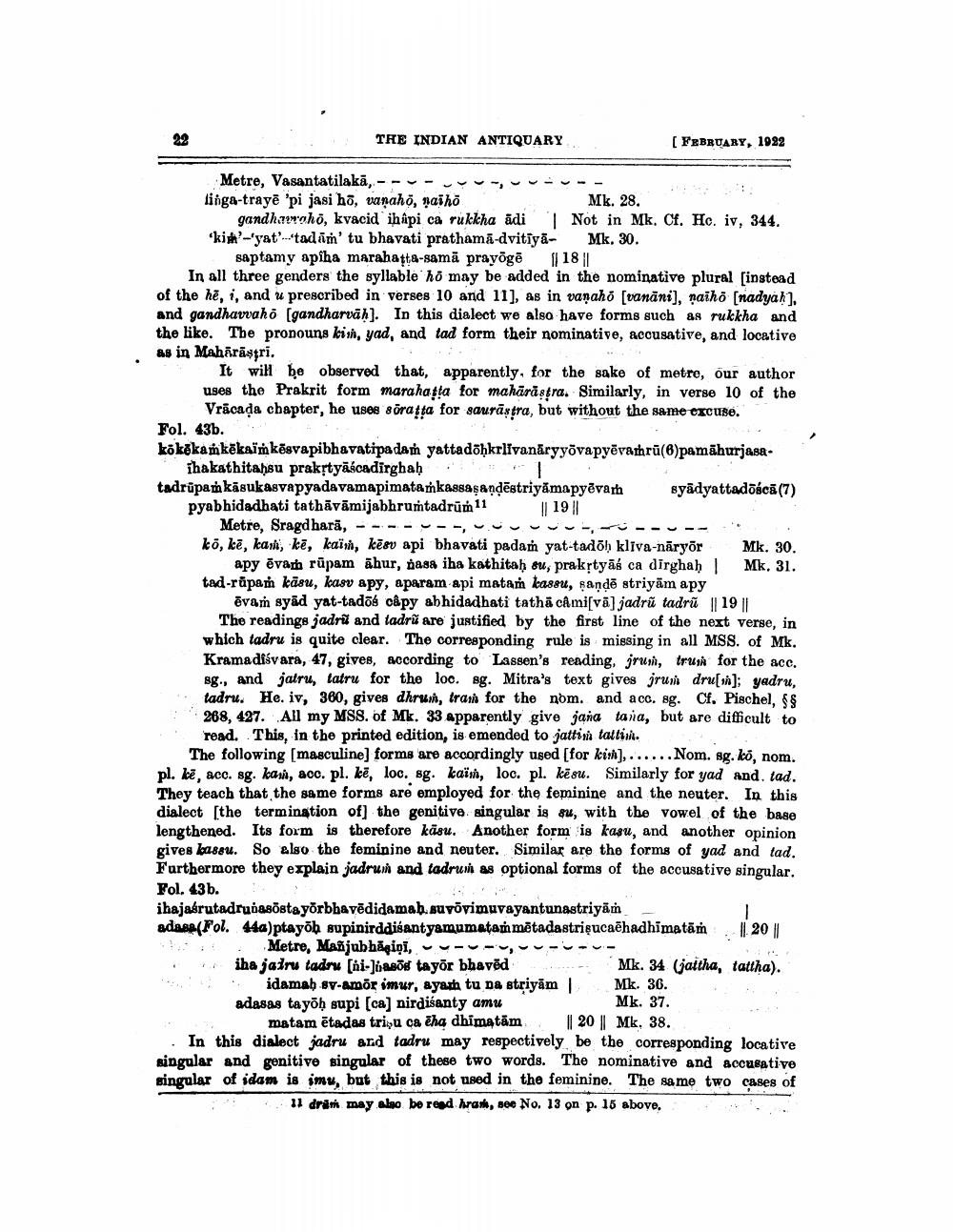________________
THE INDIAN ANTIQUARY
(FEBRUARY, 1922
Metre, Vasantatilakā, --- - - -- linga-trayē 'pi jasi ho, vanaho, naiho
Mk. 28. gandhauroho, kvacid ihîpi ca rukkha ādi | Not in Mk. Cf. Hc. iv, 344. 'kish-yat-tadam' tu bhavati prathamā-dvitiya- Mk. 30.
saptamy apiha marahatta-samā prayogē 18|| In all three genders the syllable ho may be added in the nominative plural finstead of the he. i. and u prescribed in verses 10 and 11), as in vanaho [vanāni), naiho snadyah 1. and gandhavvaho (gandharvän). In this dialect we also have forms such as rukkha and the like. The pronouns kein, yad, and tad form their nominative, accusative, and locative es in Mahārāsfri.
It will be observed that, apparently, for the sake of metre, our author uses the Prakrit form marahatta for mahārāstra. Similarly, in verse 10 of the
Vrācada chapter, he uses 8õrafta for saurāxtra, but without the same excuse. Fol. 43b. kökökamkēkainkēsvapibhavatipadam yattadõhkrlivanāryyövapyēvazhrū(6)pamāhurjaga. ihakathitahsu prakrtyascadirghah
! tadrüpath kasukasvapyadavamapimatamkassasandēstriyāmapyēvarh syādyattadāscā (7) pyabhidadhati tathāvāmijabhrumtadruń 11 || 19 || Metre, Sragd harā, ---- - -
- - -- -- kö, kē, kami, kē, kaïri, kēsv api bhavati padam yat-tadoh kliva-nāryõr Mk. 30.
apy ēvam rūpam āhur, nasa iba kathitaḥ su, praktyās ca dirghah Mk, 31. tad-räpa kāsu, kasv apy, aparam api matam kassu, kandē striyām apy
ēvam syād yat-tados câpy ahhidadhati tathā cAmi[vā] jadrū tadrā || 19 || The readings jadri and ladrã are justified by the first line of the next verse, in which tadru is quite clear. The corresponding rule is missing in all MSS. of Mk. Kramadfávara, 47, gives, according to Lassen's reading, jrusk, run for the acc. sg., and jatru, latru for the loc. sg. Mitra's text gives jruri dru[n]; yadru, tadru. He. iv, 360, gives dhrui, tram for the nom. and acc. sg. Cf. Pischel, $$ 268. 427. All my MSS. of Mk. 33 apparently give jana taia, but are difficult to
read. This, in the printed edition, is emended to jattina tattini.
The following (masculine) forms are accordingly used (for kish), ......Nom. sg.kö, nom. pl. ke, acc. sg. kas, acc. pl. lē, loc. sg. kaïm, loc. pl. kësu. Similarly for yad and. tad. They teach that the same forms are employed for the feminine and the neuter. In this dialect [the termination of) the genitive singular is su, with the vowel of the base lengthened. Its form is therefore käsu. Another form is kasu, and another opinion gives kas8u. So also the feminine and neuter. Similar are the forms of yad and tad. Furthermore they explain jadrun and tadrum as optional forms of the accusative singular. Fol. 43b. ibajasrutadruvasõsta yõrbhavēdidamab, suyovimuvayantunastriyam adas (Fol. 44a)ptayõb supinirddisantyamumatammētadastripucaēhadhimatām || 20 ||
Metre, Maxjubhāgini, - -- - - --- iha jainu tadru (ni-Jaah tayõr bhavēd . Mk. 34 (jaitha, tattha).
idamah sy-amor imur, ayah tu da striyām Mk. 36. adasas tayoḥ supi (ca) nirdisanty amu
Mk. 37. matam ētadas tri,u ca iha dhimatām , 20 Mk. 38. . In this dialect jadru ard tadru may respectively be the corresponding locative singular and genitive singular of these two words. The nominative and accurative singular of idam is imu, but this is not used in the feminine. The same two cases of 11 drämh may also be read hrani, see No. 13 on p. 16 above.
.




